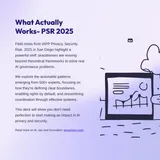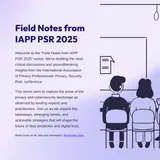Using the NIST Digital Identity Guidelines in the Age of AI
NIST SP 800-63-4 updates digital identity guidelines to address AI-enhanced threats, requiring phishing-resistant authentication and risk-based approaches for secure identity verification amid AI risks

Temoshok, D., Choong, Y., Galluzzo, R., LaSalle, M NIST SP 800-63-4: Digital Identity Guidelines | NIST., Regenscheid, A., Proud-Madruga, D., Gupta, S. and Lefkovitz, N. (2025), NIST SP 800-63-4: Digital Identity Guidelines, Special Publication (NIST SP), National Institute of Standards and Technology, Gaithersburg, MD, [online]
The rapid evolution of artificial intelligence has fundamentally altered the digital authentication landscape, making robust identity verification more critical than ever. Based on the newly published NIST Special Publications 800-63-4 and 800-63B-4 from July 2025, organizations face an unprecedented challenge: confirming authentic human identity in an environment where AI can generate convincing synthetic content, automate sophisticated attacks, and blur the lines between human and machine interactions.
The NIST guidelines, which supersede previous versions and provide updated technical requirements for identity proofing, authentication, and federation, now explicitly address AI's dual role as both a tool for identity systems and a source of new threats. This creates a complex environment where traditional authentication methods must be reconsidered through the lens of AI capabilities.
The AI-Enhanced Threat Landscape
The guidelines acknowledge that digital identity risks exist along a continuum and have become increasingly dynamic. AI amplifies several categories of authenticator threats that NIST catalogues, including sophisticated phishing attacks, synthetic identity fraud, and presentation attacks against biometric systems. Where attackers previously needed significant technical expertise to execute complex impersonation schemes, AI democratizes these capabilities.
Consider the implications for biometric authentication, which the guidelines require to operate with a false match rate of one in 10,000 or better. AI-generated deepfakes and sophisticated presentation attacks can potentially circumvent these systems, leading NIST to mandate presentation attack detection for facial recognition while prohibiting voice-based biometric authentication entirely. The guidelines state that biometric systems "SHALL implement PAD for facial recognition" precisely because AI has made spoofing attacks more accessible and convincing.
Similarly, the rise of large language models capable of generating convincing phishing content has influenced NIST's emphasis on phishing-resistant authentication. The guidelines now require that "verifiers SHALL offer at least one phishing-resistant authentication option at AAL2" and mandate phishing-resistant authentication for federal agencies. This represents a significant shift from previous guidance and reflects the reality that AI can generate more persuasive social engineering attacks at scale.
Digital Identity Risk Management in the AI Era
The updated Digital Identity Risk Management (DIRM) process provides a framework for addressing AI-related risks through a two-dimensional approach. The first dimension focuses on risks that might be addressed by an identity system, while the second addresses risks introduced by the identity system itself. This framework becomes particularly relevant when AI is integrated into identity processes.
Organizations must now consider how AI affects their impact assessments across five key categories: degradation of mission delivery, damage to trust and reputation, unauthorized access to information, financial loss, and threats to human safety. AI can amplify the potential harm in each category. For instance, an AI-powered attack that successfully compromises an authentication system could enable large-scale automated fraud, dramatically increasing financial losses compared to traditional manual attacks.
The guidelines establish three Authentication Assurance Levels (AAL1, AAL2, AAL3) with increasingly stringent requirements. In an AI-enhanced threat environment, organizations may find themselves gravitating toward higher assurance levels. AAL3, which requires phishing-resistant authenticators with non-exportable private keys, provides stronger protection against AI-enabled attacks but comes with implementation complexity and user experience trade-offs.
Authentication Technologies and AI Considerations
The guidelines detail specific authenticator types and their vulnerabilities in the current threat landscape. Passwords, while still permitted, face increased risks from AI-powered credential stuffing and password generation attacks. NIST now requires passwords used as single-factor authenticators to be at least 15 characters long and prohibits composition rules that might create predictable patterns exploitable by AI systems.
Multi-factor authentication becomes more critical in an AI environment, but the guidelines acknowledge that not all factors provide equal protection. Cryptographic authenticators with non-exportable keys offer the strongest defense against AI-enabled attacks because they cannot be easily duplicated or stolen for use in automated attack campaigns.
Out-of-band authentication faces particular challenges from AI. The guidelines prohibit the comparison of secrets from primary and secondary channels to prevent "authentication fatigue" attacks, where AI could potentially automate repeated authentication requests to overwhelm users into approving fraudulent attempts.
Privacy and AI Integration Requirements
The guidelines introduce specific requirements for AI and machine learning use in identity systems. Organizations must document all AI/ML usage and disclose it to relying parties. This transparency requirement is crucial because AI introduces new privacy risks, particularly around algorithmic bias and the potential for discriminatory outcomes in identity verification processes.
The guidelines mandate that organizations using AI/ML systems "SHALL provide information on the methods and techniques used for training their models, a description of the data sets used in training, information on the frequency of model updates, and the results of all testing completed on their algorithms." This requirement addresses concerns about the "black box" nature of many AI systems and ensures that organizations understand the tools they're deploying for identity verification.
Additionally, privacy risk assessments for AI/ML systems are mandatory, reflecting recognition that these technologies can process personal information in ways that create new privacy harms. The guidelines recommend implementing the NIST AI Risk Management Framework to evaluate these risks systematically.
Continuous Authentication in an AI World
The concept of session monitoring, or continuous authentication, gains particular relevance in an AI context. The guidelines describe evaluating session characteristics including "usage patterns, velocity, and timing" as well as "behavioral biometric characteristics" to detect potential fraud during active sessions.
AI enables more sophisticated analysis of these patterns, potentially identifying anomalies that indicate account takeover or automated access. However, AI also enables attackers to better mimic legitimate user behavior, creating an arms race between detection and evasion capabilities.
Implementation Challenges and Trade-offs
Organizations implementing these guidelines in an AI-enhanced environment face several practical challenges. The push toward higher assurance levels and phishing-resistant authentication can create friction for legitimate users. The guidelines acknowledge this through their emphasis on customer experience and usability considerations.
The continuous evaluation requirements become more complex when AI is involved. Organizations must track not only traditional metrics like pass rates and fraud indicators but also the performance of AI systems within their identity infrastructure. This includes monitoring for bias, accuracy degradation, and adversarial attacks against AI components.
The tailoring process described in the guidelines allows organizations to adjust baseline controls based on their specific threat environment and user populations. In sectors where AI-powered attacks are particularly prevalent, organizations might implement supplemental controls beyond the baseline requirements. Conversely, in lower-risk environments, organizations might find that baseline protections are sufficient even as AI capabilities advance.
Ensuring Human Presence and Intent
Perhaps the most fundamental challenge that AI poses to digital identity is the question of confirming human presence and intent. The guidelines address this through authentication intent requirements, which demand explicit user action for each authentication event. At AAL3, all authentication processes "SHALL demonstrate authentication intent from at least one authenticator."
This requirement becomes more critical as AI becomes capable of automating more aspects of system interaction. The guidelines specify that authentication intent "is a countermeasure against malware at the endpoint as a proxy for authenticating an attacker without the subscriber's knowledge." In an AI context, this protection extends to preventing AI systems from authenticating on behalf of users without their explicit knowledge and consent.
Biometric systems present particular challenges for confirming human presence. The guidelines note that "using a front-facing camera on a mobile phone to capture a face biometric does not necessarily constitute intent, as it can be reasonably expected to capture a face image while the device is used for other non-authentication purposes." Organizations must implement explicit mechanisms to establish authentication intent when AI could potentially generate or manipulate biometric samples.
Strengthening the Identity Ecosystem
The updated NIST guidelines recognize that confirming human identity in the age of AI requires a comprehensive approach that goes beyond individual authentication events. The Digital Identity Acceptance Statement requirement ensures that organizations document their risk management decisions and communicate them to stakeholders. This transparency becomes crucial when AI technologies introduce new variables into identity verification processes.
The guidelines' emphasis on federation and interoperability also supports a stronger overall identity ecosystem. By enabling trusted identity providers to serve multiple relying parties, federation can concentrate expertise and resources for combating AI-enabled attacks while reducing the burden on individual organizations to implement sophisticated countermeasures.
As AI continues to evolve, the principles established in these guidelines provide a foundation for adapting identity systems to new threats and capabilities. The risk-based approach, emphasis on phishing resistance, and requirements for continuous evaluation create a framework that can accommodate future technological developments while maintaining the fundamental goal of confirming that authentic humans are accessing digital systems.
The intersection of AI and digital identity represents one of the most significant challenges in cybersecurity today. The updated NIST guidelines provide essential guidance for navigating this landscape, but successful implementation requires ongoing vigilance, adaptation, and commitment to balancing security, privacy, and usability in an increasingly complex technological environment.
For more insights on where AI, regulation, and the practice of law are headed next, visit kenpriore.com.
TLDR: Executive Summary
The National Institute of Standards and Technology (NIST) Special Publications 800-63-4 and 800-63B-4 provide updated guidelines for digital identity management, focusing on identity proofing, authentication, and federation for interactions with government information systems over networks. These guidelines supersede previous versions (NIST SP 800-63-3 and 800-63B) and emphasize a risk-based approach to digital identity solution implementation, moving away from a purely compliance-oriented model. Key themes include robust risk management, enhanced security measures against evolving threats (like phishing and identity theft), a strong focus on privacy, and a significant emphasis on improving customer experience and usability. The documents define three assurance levels (IAL, AAL, FAL) for different functions of digital identity, detailing technical requirements and recommendations for each.


TL;DR: The NIST Special Publication 800-63-4: Digital Identity Guidelines and its companion volume 800-63B-4: Authentication and Authenticator Management provide comprehensive guidance for implementing digital identity services, particularly for federal agencies, though non-governmental organizations may also use them voluntarily. These guidelines supersede previous versions, introducing significant updates in risk management, privacy, customer experience, and emerging technologies.
Here are the key points a product counsel should know:
• Risk-Based Approach (Digital Identity Risk Management - DIRM):
◦ The guidelines promote a risk-based approach to digital identity solution implementation, moving away from strict compliance, and encourage organizations to tailor control implementations to their unique needs and evolving threats.
◦ The DIRM process is central, focusing on identifying and managing risks from operating online services and those introduced by the identity system itself. It involves defining the online service, conducting an initial impact assessment, selecting initial assurance levels, tailoring, and continuous evaluation.
◦ It's crucial to consider impacts on individuals, communities, and other organizations, not just the service provider.
• Assurance Levels (xALs):
◦ The guidelines define three assurance levels for different functions:
▪ IAL (Identity Assurance Level): Robustness of the identity proofing process.
▪ AAL (Authentication Assurance Level): Strength and confidence of the authentication process. Federal agencies SHALL select a minimum of AAL2 when personal information is made available online.
▪ FAL (Federation Assurance Level): Robustness of the federation process.
◦ These levels serve as baseline control sets and a starting point for risk management.
• Privacy Requirements and Considerations:
◦ Mandatory privacy controls are required for digital identity systems.
◦ Federal agencies SHALL consult with their Senior Agency Official for Privacy (SAOP) and conduct analyses to determine if collecting personal information triggers requirements of the Privacy Act of 1974 and the E-Government Act of 2002, potentially requiring System of Records Notices (SORNs) and Privacy Impact Assessments (PIAs).
◦ CSPs and IdPs processing attributes for purposes beyond identity services SHALL implement measures to maintain predictability and manageability for individuals. Consent for such additional processing SHALL NOT be a condition of providing the identity service.
◦ Biometric use is limited due to inherent privacy concerns, probabilistic nature, and susceptibility to active impersonation attacks. Biometrics SHALL only be used as part of multi-factor authentication with a physical authenticator.
• Customer Experience and Usability:
◦ Crucial for design and implementation of online services, ensuring flexibility and broad access.
◦ Organizations SHALL assess impacts on customer experience, ensuring controls do not create undue burdens or frustrations.
◦ Control tailoring allows adjustments to meet customer experience needs.
◦ Continuous improvement programs leveraging performance metrics and user feedback are essential for data-driven improvements.
◦ Federal agencies are expected to comply with Section 508 provisions, ensuring accessibility for people with disabilities.
• Authentication and Authenticator Management (from SP 800-63B-4):
◦ Phishing Resistance: Required for AAL3 and Federal enterprise staff/contractors at AAL2, and recommended for other AAL2 applications. Manual entry authenticators (e.g., out-of-band, OTPs) are not considered phishing-resistant.
◦ Multi-Factor Authentication (MFA): Required for AAL2 and AAL3. A single authenticator can provide MFA, or a combination of two single-factor authenticators can be used.
◦ Passwords: Minimum length of 15 characters for single-factor, 8 characters for MFA. Composition rules are discouraged; instead, blocklists (of commonly used or compromised passwords) SHALL be used. Periodic password changes are NOT required unless compromise is suspected.
◦ Restricted Authenticators: Specific types (e.g., PSTN for out-of-band authentication) are restricted and require organizations to assess and accept associated risks, provide alternative options to users, and have migration plans [3.2.9, 491, 492, 709].
◦ Account Recovery: CSPs SHALL support specific methods (e.g., saved/issued recovery codes, recovery contacts, repeated identity proofing) with varying requirements based on IAL/AAL [4.2.1, 4.2.2]. Account recovery events SHALL trigger notifications to the subscriber to detect fraud [4.2.3, 4.6, 631].
◦ Syncable Authenticators: These allow authentication keys to be cloned and stored in a "sync fabric" (e.g., cloud storage) [B.1, B.2]. While convenient, they introduce new risks like unauthorized key use/loss of control, sync fabric compromise, and revocation challenges [B.6]. They SHALL NOT be used at AAL3 due to non-exportability requirements, but may be used at AAL2 under strict controls [435, B.2].
• Emerging Technologies:
◦ AI and Machine Learning (AI/ML): If used in identity systems, all uses SHALL be documented and communicated to relying organizations, including training methods, datasets, and testing results. Privacy risk assessments are mandatory, and organizations SHOULD implement the NIST AI Risk Management Framework.
◦ The guidelines also prepare for new technologies like mobile driver's licenses and verifiable credentials.
• Legal Interpretation:
◦ Product counsel should pay close attention to the normative language: "SHALL" indicates a requirement, "SHOULD" indicates a recommendation, and "MAY" indicates a permissible action. This distinction is critical for compliance.
In essence, a product counsel needs to ensure that digital identity solutions are not only secure and effective but also legally compliant (especially for federal systems), privacy-protective, and user-friendly, all while managing the evolving landscape of threats and technologies through a continuous risk management process.



